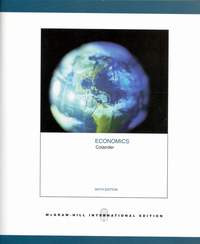
Economics
| Gmd : Text
| Availability :
| 00000010559 | HB171.5 .C788 2006 | (General Book) | Available - Ada |
This book is what would be called mainstream (it presents the conventional wisdom of ecomomists) both because I'm mainstream and because most economist are as well. But pedagogically, I also believe that students laern by questioning-to say, no, that's not right, that's not the way I see things, and then to compare their way of thinking with the conventional way. Despite my being mainstream, I'm by nature also skeptic, and in terms of pedagogy often find myself in sympathy with Joan Robinson, a famous economist, who argued that "the purpose of studying economics is not to acquire a set of ready-made answers to economic questions, but to learn how to avoid being deceived by economists." So, to encourage questioning everything, I don't present models and insights of economists as truth (the field of economics is far too complicated to have arrived at a single truth) but as a set of technical hurdles, reasoning processes, and arguments that students should know, and that will help pepare them to deal with economic issues. Economics primarily teaches you how to approach problems; it does not provide definition answers about what is wrong. It is a method, not a set of truths.
Table of Contents:
I: Introduction: Thinking Like An Economist
Chapter 1: Economics and Economic Reasoning
Chapter 2: Trade, Trade-off's and Government Policy
Chapter 3: The Evolving U.S. Economy in Perspective
Chapter 4: Supply and Demand
Chapter 5: Using Supply and Demand
II: Microeconomics
I: Microeconomics: The Basics
Chapter 6: Describing Supply and Demand: Elasticities
Chapter 7: Taxation and Government Intervention
II: Foundations of Supply and Demand
Chapter 8: The Logic of Individual Choice: The Foundation of Supply and Demand
Chapter 9: Production and Cost Analysis I
Chapter 10: Production and Cost Analysis II
III: Market Structure and Policy
Chapter 11: Perfect Competition
Chapter 12: Monopoly
Chapter 13: Monopolistic Competition, Oligopoly, and Strategic Pricing
Chapter 14: Real-World Competition and Technology
Chapter 15: Antitrust Policy and Regulation
IV: Factor Markets
Chapter 16: Work and the Labor Market
Chapter 17: Who Gets What? The Distribution of Income
V: Applying Economic Reasoning to Policy
Chapter 18: Government Policy and Market Failures
Chapter 19: Politics and Economics: The Case of Agriculture Markets
Chapter 20: Microeconomic Policy, Economic Reasoning, and Beyond
Chapter 21: International Trade Policy, Comparative Advantage, and Outsourcing
III: Macroeconomics
I: Macroeconomic Problems
Chapter 22: Economic Growth, Business Cycles, Unemployment, and Inflation
Chapter 23: National Income Accounting
II: The Macroeconomic Framework
Chapter 24: Growth, Productivity, and the Wealth of Nations
Chapter 25: Aggregate Demand, Aggregate Supply, and Modern Macroeconomics
Chapter 26: The Multiplier Model
III: Money, Inflation, and Monetary Policy
Chapter 27: Money, Banking, and the Financial Sector
Chapter 28: Monetary Policy and the Debate about Macro Policy
Chapter 29: Inflation and Its Relationship to Unemployment and Growth
IV: Macro Policy in Perspective
Chapter 30: Aggregate Demand Policy in Perspective
Chapter 31: Politics, Deficits,and Debt
Chapter 32: Macro Policies in Developing Countries
V: International Policy Issues
Chapter 33: International Financial Policy
Chapter 34: Macro Policy in a Global Setting
| Series Title |
-
|
|---|---|
| Call Number |
HB171.5 .C788 2006
|
| Publisher Place | New York |
| Collation |
xxxvi, 837p. : ill.; 26cm.
|
| Language |
English
|
| ISBN/ISSN |
0071115692
|
| Classification |
HB171
|
| Media Type |
-
|
|---|---|
| Carrier Type |
-
|
| Edition |
6th ed.
|
| Subject(s) | |
| Specific Info |
-
|
| Statement |
-
|
| Content Type |
-
|
No other version available







